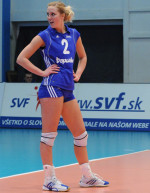Emily Brown Returns From Pro Volleyball Tour of Slovakia
June 26, 2009
Former Kansas volleyball standout Emily Brown recently spent four months playing professional volleyball for Doprastav Voleibal Klub in Bratislava, Slovakia. Emily reflects on the culture challenges, language barrier and her experiences.
Take us through the process of how you got involved with playing in Slovakia.
Emily Brown: I went over as a part of a short tour. A group of Americans went over there hoping to get picked up by the coaches that came to watch the training sessions. I left January 7 for Europe and I had a return ticket for January 18 – it was a two week tour. If you got picked up you stayed until the end of the season, but if you didn’t then you came home two weeks later. I had no idea that I was going to stay.
What was the tour like?
Emily Brown: On the tour there were about 40 girls and they had busses for us to travel around in to the different spots on the tour. They were really specific with their guidelines. You could only bring one bag and it had to be a soft suitcase and a normal size. Plus, it was winter in Europe, so all your clothes are bigger. That was kind of a problem – I had to wear the same thing every two days.
So after the tour you were picked up by a team. Describe your team…were there any other Americans?
Emily Brown: Most of the girls were Slovakian, but from all over the country, not just from Bratislava. Other than that, there was one girl from Poland and me. The girls on the team were really nice. Most of them were around my age or a year or two younger. A lot of them were still in school at universities. It was hard to make strong friendship connections because of the language barrier. The girls that were fluent were very helpful and, of course, Facebook connects everyone.
How difficult was it to adjust to the language?
Emily Brown: I actually got pretty lucky because a lot of them knew English from school. Probably three or four of them didn’t know any English at all. We always had to communicate through other people, but most knew enough to help me, even if it was just key words. My coach was also fluent in English, which is very rare. It was good for me because I wasn’t forced to learn the language.

With a team made up mostly of Slovakians, it must have been difficult to keep up with the coach when he was addressing the team.
Emily Brown: It was always all in Slovakian. I would just have the girls translate it the best they could. Practices were also difficult. Coach would talk for 10 minutes, explaining the drill and telling us what to do, and I would have no idea what he was saying. I would either have to watch the others and figure out for myself what was going on or he would talk for 10 minutes and then just tell me to pass somewhere. Some of the drills took a while because I couldn’t understand. I just had to learn by mimicking the others.
Describe your living conditions.
Emily Brown: As a culture, the Slovakians are more independent. For instance, I lived in an apartment with five of my teammates. It was a big place and really nice, but there was no common area except for the kitchen. When we were at home, everyone stayed in their own rooms. When I wasn’t in the gym I really wasn’t around other people. There are a lot of places like that there.
Was that difficult to get used to? What other type of cultural differences were there?
Emily Brown: They have interesting style choices there. I saw a lot of different hairstyles and fanny packs. We also did this thing called “regeneration” where we had a masseuse and a hot tub. It’s kind of like our version of an athletic trainer except over there he is only a masseuse. Athletic training is nowhere near what it is here. Girls on my team would have to tape themselves after an injury!
How was the food?
Emily Brown: We got one meal a day from the cafeteria which was pretty good. They eat a lot of soup and they eat it at every meal. They also serve a lot of meat and potatoes or meat and rice. For our other meals we were on our own.
Was it difficult to prepare your own meals?
Emily Brown: I couldn’t read labels, so it was difficult for me to try and make food on my own. I tried about eight different things looking for sour cream. I even looked it up on Google Translator trying to figure out how it would look, and I still could not find it! But there happened to be a little section in the grocery store of American-brand Mexican food. I made fajitas one night by myself and one of my roommates kept looking at it and trying to figure out what I was making. They had never seen a tortilla before. I did get them hooked on chips and salsa.
Did you share your cuisine with anyone?
Emily Brown: There was a men’s team that was a part of our club and we were friends with them. They heard that I had made fajitas and asked me to make them sometime. So one day I went over to their apartment to make fajitas, and when I showed up, there were 10 extra people there. They had spread the word that “the American was going to cook dinner tonight.” I ended up making tacos and fajitas and they loved it!
How much travel to get to experience with your team?
Emily Brown: They did most of their travel the first half of the season. I got there in January, which is the second half of the season, which is more of league play. We just traveled around our country. I did go to Croatia, which was a 10-hour bus ride. It is really pretty because it is so simple. There are no skyscrapers. I lived in a big city, but once you got out of the city limits you drive through the mountains and every once in a while you’ll see castle ruins at the top of a mountain or cliff.
Did you ever head out on your own to see any sights?
Emily Brown: I did some traveling on my own at the end of the season. I was in a good location because I could take a train. I took a train to Vienna, Budapest and Prague. I just found places to stay and walked around for two days.
Sounds like you had a great experience. Any plans to do it again?
Emily Brown: I want to go back. This is my chance to see the world and take in all the different cultures.

